FIRST FLAGS
OVER CANADA |
|
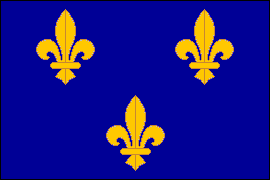
THE ROYAL BANNER OF FRANCE |
|
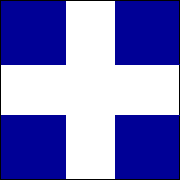
FRENCH MERCHANT ENSIGN
Early 17th Century |
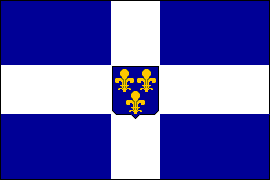
FRENCH MERCHANT ENSIGN
18th Century |
|
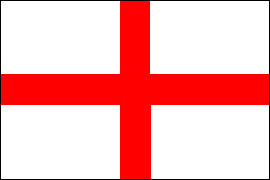
THE CROSS OF ST.
GEORGE |
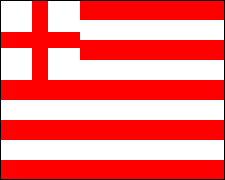
ENSIGN OF THE
EAST INDIA COMPANY |
|
The first
flags to be flown over the lands that became Canada were those
of the rival colonial powers: France and Britain. The early
French explorers no doubt bore the French Royal Banner, and
later the various French naval and merchant ensigns became a familiar
sight in Canadian waters. The Cross of St. George was the first
English flag to make its appearance, and in 1610 when the
English explorer Henry Hudson sailed into the immense bay that
was to be named after him, his ship, the Discovery,
may have flown an early version of the ensign of the
East India
Company, which financed his final (and fatal) expedition in
search of a Northwest Passage.
|
|
THE UNION JACK IN CANADA |
|
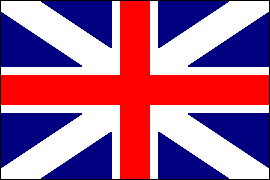
FIRST UNION FLAG • 1606-1801 |
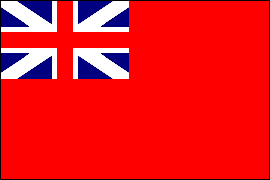
THE METEOR FLAG
• 1707-1801 |
|
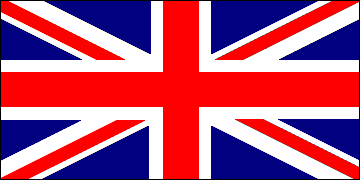
THE ROYAL UNION FLAG SINCE 1801 |
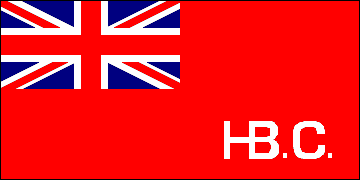
HUDSON'S BAY
COMPANY FLAG |
|
As
in the territory of the future United States, the
British Union
Flag, popularly known as the Union Jack, was colonial Canada's
national flag. From 1606 to 1801, the Union Jack combined the
crosses of SS. George and Andrew, symbolizing the union of England
and Scotland in the Kingdom of Great Britain. In 1801, when Ireland
was added to create the United Kingdom of Great Britain and Ireland,
the diagonal Cross of St. Patrick was added to create the current
Union Jack. This remained Canada's official national flag until
1965, when the Maple Leaf Flag was adopted. It was however, retained as an official Canadian flag
(the Royal Union Flag) and it is
flown together with the Maple Leaf Flag on designated days and
certain occasions, e.g. the Queen's Birthday and Commonwealth Day.
Except on the occasion of a royal visit, the Maple Leaf Flag takes
precedence over the Royal Union Flag.
Of
the Union Jack's numerous variants, the Red Ensign was also
frequently seen in colonial Canada. Popularly known as
the Meteor Flag, it was an ensign of the Royal Navy from 1707 to 1864 and the
British civil ensign thereafter. Along with the British Blue Ensign,
this flag was adapted for numerous colonies of the British Empire,
usually by adding a badge in the fly. In Canada, the Hudson's Bay
Company used a Red Ensign with the its initials in the lower fly. |
|
THE CANADIAN RED
ENSIGN |
|
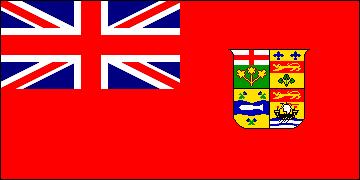
1892-1922 |
|
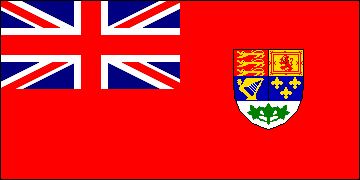
1922-57 |
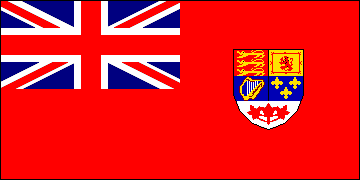
1957-65 |
|
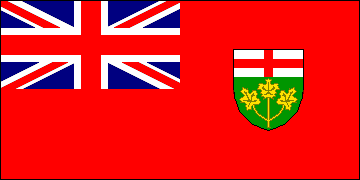
PROVINCE OF ONTARIO SINCE 1965 |
|
In 1868, a
year after the creation of the Canadian confederation, a Great
Seal for Canada, combining the arms of the provinces of Ontario,
Québec, Nova Scotia and New Brunswick, was established by royal
warrant. Soon thereafter, this device was applied to the British
Red Ensign to create a distinctive Canadian flag. Though for
many years it enjoyed no official recognition, this flag quickly
became popular and in 1892 it was belatedly confirmed as Canada's civil ensign.
Though intended purely for use at sea, the Canadian Red Ensign
was widely flown on land as well and soon came to be regarded as
Canada's de facto national flag. In the 1920s the
Canadian government authorized it to be flown by the Canadian
High Commission in London and the Canadian Embassy in
Washington, DC. During World War II, the government directed the
Canadian Army overseas to use it as a flag of nationality when appropriate.
In 1945, a Canadian order in council authorized the Canadian Red
Ensign to be flown on government buildings inside and outside
Canada pending the adoption of a definitive Canadian national
flag.
There were
three official versions of the Canadian Red Ensign. In 1922 Canada's new
coat of arms replaced the great seal, and in 1957 the maple
leaves in the base of the shield were changed from green to red,
white and red being Canada's livery colors. The Canadian Red
Ensign's long career came to an end in 1965, with the adoption
of the current national flag. In Manitoba and
Ontario, however, sentiment in favor of the Union Jack
remained strong, and in 1965-66 they both adopted provincial flags based on the Red
Ensign. |
|
PROPOSALS FOR A NEW CANADIAN FLAG |
|
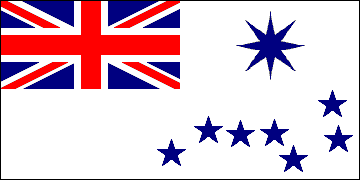
1930 PROPOSAL |
|
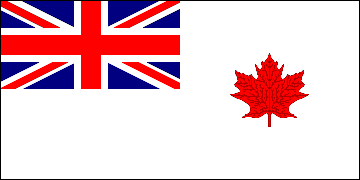 |
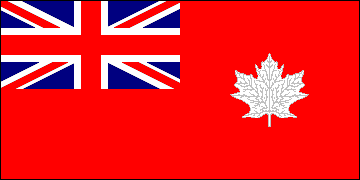 |
|
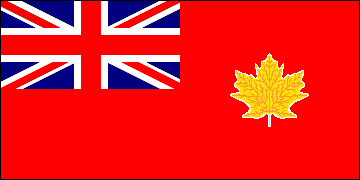
1946 JOINT PARLIAMENTARY COMMITTEE PROPOSALS |
|
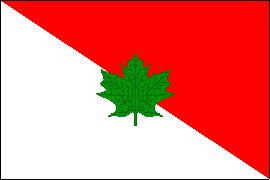
GODBOUT'S 1947 PROPOSAL |
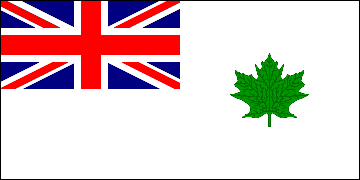
HOLLINGSWORTH'S
1955 PROPOSAL |
|
In the years
following confederation, and particularly after World War I,
there were numerous proposals for a distinctive Canadian flag.
Most of them were based on the Union Jack and many incorporated
the maple leaf, which had come to be accepted as a symbol of
Canada after its appearance in the coat of arms of Ontario, but
none ultimately found favor. The inclusion of Francophone
Québec
in the confederation was the primary complicating factor, but
even among English-speaking Canadians there were divisions of
opinion between those who cherished the British connection and
those who wished to emphasize a purely Canadian national
identity. One interesting design proposed in 1930 drew
inspiration from the Australian flag, which depicts the Southern
Cross constellation. The Canadian proposal, like the much later
state flag of Alaska, displayed the Big Dipper, plus a "confederation
star." In 1946 a parliamentary joint committee formed for
the purpose of selecting a new flag for Canada recommended a Red
Ensign with a golden yellow, white-bordered maple leaf in place
of the Canadian arms. But Francophone Canadians were opposed to any new flag that retained the Union Jack and the
prime minister, Mackenzie King, shelved the committee's
proposal.
Francophone Canadians were generally in favor of a national
flag whose symbolism was neutral: Canadian rather than British
or French. Adélard Godbout, a former premier of
Québec
suggested in 1947 that a flag diagonally divided from upper
hoist to lower fly, red over white, charged with green maple
leaf, would make an acceptable Canadian flag. This was in fact the flag of the of the League of the Canadian Flag, an
organization devoted to the adoption of a distinctive flag for
the nation. Godbout's proposal pointed the way forward,
incorporating the elements of the future Canadian flag: the
colors red and white, and the maple leaf. But the Red Ensign
remained popular with many English-speaking Canadians. When
Liberal MP A. H. Hollingworth introduced a bill for the
adoption of a new flag in 1955, he thought it essential that the
Union Jack be retained. The white field of his proposed flag was
intended to appeal to Francophone Canadians, white
being the color of royalist France. But neither these
flags nor the many other designs proposed in the 1950s found
favor, and the Canadian Red Ensign soldiered on. |
|
THE GREAT CANADIAN FLAG DEBATE |
|
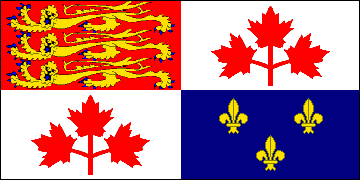
1964 PROPOSAL |
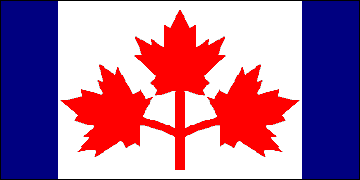
THE PEARSON
PENNANT |
|
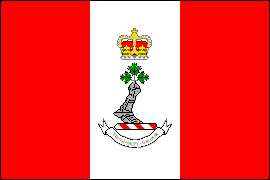
ROYAL MILITARY COLLEGE OF CANADA |
|
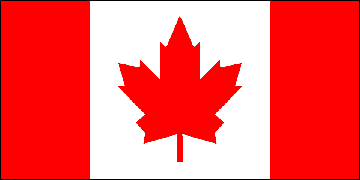 |
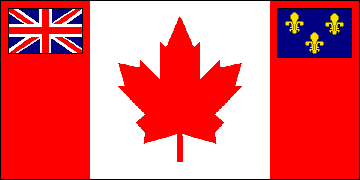 |
|
Group B Finalist
1964 PARLIAMENTARY COMMITTEE DESIGNS
Group C Finalist |
|
The long-running
flag debate came to a head in 1964 when the new Liberal Prime Minister, Lester
Pearson, placed the
issue before Parliament. Pearson, who had campaigned on the
promise of a new flag for Canada, favored a design with the three
red maple leaves from the Canadian arms on a field of white
between two vertical blue stripes. This flag had the advantages
of being distinctively Canadian, of incorporating the colors of
the Union Jack, of including blue for Francophone Canada and of
suggesting the national motto: "From Sea to Sea." But the
Pearson Pennant, as it came to be called, had the disadvantage
of being too closely associated with Pearson and the Liberals.
John Diefenbaker, leader of the
Progressive Conservatives and former prime minister, not only
opposed the Pearson Pennant but argued strongly that the Red
Ensign should be retained. The result was an extended and
acrimonious parliamentary debate. Finally a committee of fifteen
MPs was formed to consider the large number of proposals. The
flag eventually selected was designed by
George F.G. Stanley and inspired by the flag of the Royal
Military College of Canada. The committee considered two
variants: one with a red maple leaf on a white field between two
vertical red stripes and one with the Union Jack and the Banner
of France added. Both variants had 1:2 proportions, with each red
stripe taking up a quarter of the flag's total area. Stanley's
original, simple design (Group B Finalist) was approved
unanimously by the committee on 29 October 1964, and adopted by
a majority vote in the House of Commons on 15 December 1964. The
Senate's approval came two days later. |
|
THE MAPLE LEAF
FOREVER |
|

NATIONAL FLAG SINCE 1965 |

CANADIAN CUSTOMS ENSIGN |
|
As finally adopted,
the new flag was slightly modified to depict an eleven-point
maple leaf. In this form it was submitted to Queen Elizabeth II
for her royal assent, which was duly given on 28 January 1965.
The Maple Leaf Flag was officially hoisted for the first time on
15 February 1965. The ceremony took place on
Parliament Hill, Ottawa, in the presence of the Governor General
of Canada, the Prime Minister, the members of the Cabinet, and
members of Parliament. At the stroke of noon, the Canadian Red
Ensign was lowered and the Maple Leaf Flag was raised. The crowd
then sang "O Canada" followed by "God Save the Queen."
Since 1965, a number
of Maple Leaf Flag variants have been adopted, mostly by the
armed forces.
Another example is the ensign of Canadian Customs, which is similar
to the British customs ensign, with the Maple Leaf Flag replacing
the Union Jack.
|

























